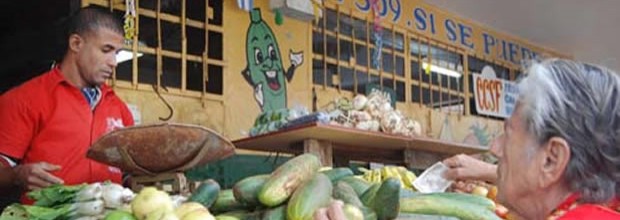
In Cuba’s non-state sector, prices skyrocket
HAVANA — More than 20 percent of the licenses for self-employed labor issued in Cuba — about 450,000 — are concentrated in the capital. In these activities are involved 8.7 percent of the people of working age in the province, one of the highest percentages on the island.
However, more than 40 percent of the licenses issued in the past two years have been returned. To the lack of expertise of some entrepreneurs is added a critical factor: the lack of wholesale markets where they can obtain supplies to ensure efficient and profitable productive cycles.
To those who have quit and to those who are going ahead, sometimes “the money is not there,” and the losers turn out to be the consumers, who have to pay prices that never stop climbing.
Within the new forms of non-state management, the creation of cooperatives in former state-owned buildings is a modality that began experimentally in 2009 in barbershops and hairdressing parlors and was extended in 2012 to other economic activities.
According to data from the Ministry of Domestic Trade, until September 2013, more than 2,000 workplaces had been leased to more than 5,000 workers, who became responsible for maintenance, supply, setting schedules and shifts, and setting prices according to supply and demand.
But the demand clashes with the lack of an ample supply — sufficient, at least — that satisfies the basic needs of the consumer, the entrepreneurs and the population at large.
Although the first steps were taken, a wholesale market was not created for the workers who embarked on the new models of non-state management.
The first experience of that type in the capital was the farmers’ supply outlet called “El Trigal,” in the municipality of Boyeros, which opened last December. But even there, the prices — the most important indicator to the clients — continue to rise.
The restructuring of the wholesale market on a nationwide basis was one of the tasks planned for 2013. but beyond the measures published that year in the Special Issue No. 17 of the Official Gazette about the possibility of selling the surplus products –at supply-and-demand prices — no noticeable advance has been made.

“We first had to buy our supplies at the Universal Stores at very high prices, so we had to raise our prices, too. It is not the same as if we bought them at a store, because there’s fewer intermediaries, but the quality is not very good and we seldom find what we want,” says Adriana Cervantes, manager of the Health and Beauty Institute at Calzada and Paseo. Last Oct. 1, the Institute became a cooperative.
Something similar happened at the farmers’ market at 19th and 48th streets in Playa, where the prices rose noticeably, even though the new system permitted the elimination of a long list of intermediaries between the producers and the clients.
“At this moment, the owner of the merchandise sets the prices,” says Carlos Smith, the manager. “Who regulates the prices? The demand. When the production increases, logically the prices have to drop, because of the competition.”
While a growing improvement is noticeable at both stores, in terms of the variety and quality of the supplies, the increase in prices was inevitable because “the shopping list and our budget don’t match,” as Adriana Cervantes puts it. This aspect directly affects everyone, in view of the low purchasing power of Cubans, especially those who work for state-owned businesses.
According to the latest figures from the National Office of Statistics, the average monthly wage in Cuba in 2012 was 489 Cuban pesos [$18.50 at today’s rate of exchange]. It is no secret that in most cases the earnings of “cuentapropistas” [self-employed workers] were higher than that. This not-too-subtle difference is essential in the outlook of the workers.
Is the nation’s labor force moving from one sector to another? Is it possible to increase national production in the immediate future? Where did the workers made redundant in the 2011 reshuffle go? These are just a few of the related questions.
The increase in earnings in the self-employed sector has been the advantage emphasized the most by the people we interviewed. Among other benefits, they list the chance to manage their daily schedules, the nearness to their homes, the autonomy and the flexibility to organize and manage the work.
The 29 workers at the Institute of Health and Beauty “earn up to 3,000 and even 4,000 pesos,” Adriana says [$113 to $151 a month]. Here, people earn more than a professional. For that reason, despite all problems, we’re doing well. And now we have to pay the utilities for these three months, which amount to 1,000-plus pesos [$38-plus].”
Among the advantages of this new model, we could add the increase in sources of employment, a greater feeling of belonging on the part of the workers and the tax contribution to the nation’s economy. But all that remains to be seen.
At the farmers’ market at 19th and 48th streets, sales last December amounted to 82,000 pesos [$3,095]. The workers split 10 percent of the earnings, minus a rental fee of about 600 pesos [$22.65], plus their fixed salary.
“The change has been very positive, you can see it in the line that forms outside,” says Carlos, very pleased by the results of the business, so far. “Every morning there’s a crowd. Before, we almost had to pull the customers in because the quality of the merchandise was so low. The workers are very happy now. They’re working, whereas in the past they spent the days idle.”
At the Beauty Institute, for example, a hairdresser can earn up to 7,000 pesos a month [$265], depending on the volume of work. At the Carmelo de Calzada Restaurant in the Vedado district, another establishment being converted into a cooperative, manager Félix Artiaga estimates that the wages of the food workers can rise to 3,000 pesos [$113] a month.
“Here, people don’t like to work because they’re not well paid, because there’s no exigence, because of a million reasons. But as soon as they leave the country they realize that things are different. They have to work, and they do. Does their mindset change? That’s what should happen here now,” Artiaga says.
As a result, the widespread phenomenon of fraud and corruption that was typical for that kind of establishment has decreased, our interviewees say. “Now the dynamics are different,” Felix says, “because the level of exigence is different. Now there is real remuneration. [The workers] don’t have to steal; their earnings are in the job, not in deception.”
The government estimates that by 2015 the non-state sector will contribute 40 percent of the Gross National Product and will employ 35 percent of the labor force. Of these, almost 15 percent would be self-employed workers.
All this will improve, you might think. And maybe it will. But, for the time being, the consumers don’t see any greater benefits. Many continue to perform magic with their wages and whatever else they can raise to purchase services and products whose prices today are subject to the market — pure and tough — and the rules of money — in coins and bills.
Progreso Semanal/ Weekly authorizes the total or partial reproduction of the articles by our journalists, so long as source and author are identified.

